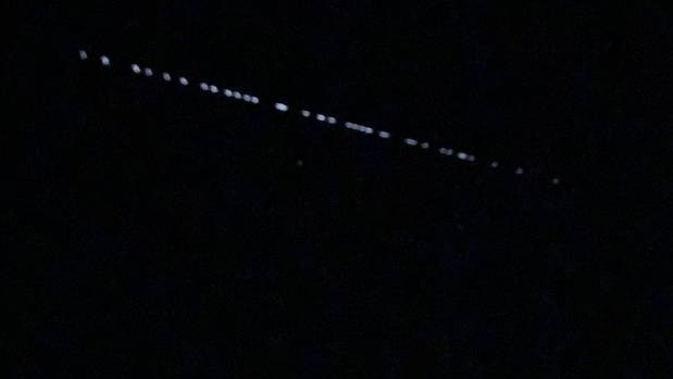
Residents across New Zealand last night were reporting an "extremely odd" string of 30 to 40 lights in a straight line crossing the sky from west to east.
Torbay resident on Auckland's North Shore Dwayne Alexander said it was one of the strangest thing he'd ever seen, as a sting of lights in a straight line passed quickly across the sky and disappeared behind some clouds.
"There must have been around 30 to 40 lights close together going south east," Alexander said.
"They then disappeared."
What’s happening in the sky #auckland #shootingstars pic.twitter.com/22RYvILh2y
— Nees NZ (@NeesNZ) February 1, 2020
Tauranga resident Kevin Prince reported the same phenomenon in the sky.
"I've never seen anything like this. There was this unusual string of lights in a perfectly straight line moving across the sky. They looked like satellites, 40 lights moving from west to east.
"It definitely wasn't a shooting star."
Penny Mark said: "We're sitting on the deck at Cooks Beach and just seen what we believe to be space satellites in the night ski.
"About 60 or so bright dotted lights moving across the sky after each other like a train."
This week SpaceX, led by Elon Musk, launched its Falcon 9 rocket launch from pad 40 at Cape Canaveral Air Force Station in Florida.
The 80th flight of a SpaceX Falcon 9 rocket delivered 60 more satellites to orbit for the company’s Starlink broadband network Wednesday after launch from Cape Canaveral Air Force Station (📷: @SpaceX). PHOTO GALLERY: https://t.co/AuZgT6Z7sR pic.twitter.com/yIeG4x48iV
— Spaceflight Now (@SpaceflightNow) February 1, 2020
Video posted by space news website SpaceFlight Now shows 60 satellites separating from the rocket for the company's Starlink broadband network as it flew in orbit south of Australia.
To date SpaceX have launched four sets of 60 Starlink satellites. One set back in May of 2019, another in November 2019 and the most recent on January 30.
SpaceX Starlink satellite engineer Lauren Lyons explained the satellites at the launch from Cape Canaveral Air Force Station in Florida on January 30.
/arc-anglerfish-syd-prod-nzme.s3.amazonaws.com/public/EI7GOCOKBNEU3B7FCNT72QX5XA.jpg)
The lights pass over Omana Regional Park. Photo / Rachel Broadbent
"This network of relatively small but advanced satellites is designed to bring high speed low latency broadband internet to people all over the globe," Lyons said.
"By design these satellites will be able to service areas of the globe where connectivity has been unreliable, too expensive or completely unavailable."
On January 16, Tauranga residents also reported seeing a tight formation of bright lights travelling across the sky.
The series of satellites was also believed to have been the second launch of a Starlink Satellite train.
The Tauranga Astronomical Society posted on Facebook that the Starlink Satellite train of satellites was passing over New Zealand. The society stated the satellites were "a spectacular sight to see" but could be problematic for astrophotography.
Take your Radio, Podcasts and Music with you









